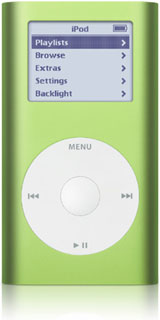2004 – In the old days of MacWeek, Apple used to send up “trial balloons” to see how the market might respond to a new product. Today we have websites that exist only because of Mac rumors, and they’ve been at the forefront of the “flash iPod” craze.

As always, this column is based on no inside sources. Instead let’s try to think like a marketer. How would you sell a lower-capacity iPod to the public?
Low Cost
 First off, it has to have a lower price. No matter how much smaller or cooler it might be, if it costs more than the US$249 iPod mini, not too many people are going to line up to buy it.
First off, it has to have a lower price. No matter how much smaller or cooler it might be, if it costs more than the US$249 iPod mini, not too many people are going to line up to buy it.
Compared to hard drives, flash memory is expensive. A 4 GB Compact Flash card sells for $370-400 these days, but the Hitachi 4 GB MicroDrive sells for just $220 configured for use in a Compact Flash slot. It kinda makes you wonder how Apple can sell a 4 GB iPod mini for $249 and make a profit. Quantity, I guess.
Looking at the market, you can buy a SanDisk 256 MB MP3 player for $70, a 512 MB player for $115, and a 1 MB model for $154. There are no 2 GB models for an obvious reason – they’d cost at least as much as the iPod mini.
Remember that we’re dealing with Apple here, and that means a premium price that people are willing to pay. If others can sell 1 GB digital music players for $150 and up, Apple will probably sell the same capacity for $199. A 512 MB model might reach the market at $149.
Should we hold out for 256 MB at $99? While Apple could do it, I don’t think there’s enough profit at that price point for Apple to go that low.
And, unlike at least one website, I don’t think Apple will cut costs by leaving the screen off the flash iPod. That’s just silly.
Low Capacity
Apple markets the iPod mini as storing up to 1,000 songs on a 4 GB hard drive. That means a 1 GB flash iPod would store 250 songs, 512 MB would have room for 125 songs, and a 256 MB model would only have room for 60-65 tracks.
Would you spend $100 for a device that only stored 60-65 songs when you can buy an MP3 CD player with 160 track capacity for about the same price? That’s another reason I think a 256 MB player would be difficult for Apple to market.
Small Size
The iPod mini showed that people are willing to pay a premium for a smaller package, and a flash iPod could be even smaller than the iPod mini. Still, I don’t think size alone is going to drive the flash iPod market.
Solid State
While I believe lower cost and a smaller size will be selling points that help offset the lower capacity of a flash iPod, I don’t think they are compelling reasons in and of themselves. There should be a more tangible benefit.
There is – flash memory. You can run some flash memory devices through the laundry, drop them, and sit on them without destroying them. Hard drives are relatively fragile, and that’s part of the reason for the iPod mini’s aluminum case.
Better yet, you can jog with solid state memory and not worry about damaging a hard drive. This is the tangible benefit, which leads me to the conclusion that Apple will christen the new model the iPod sport.
Instead of spending $249 for an iPod mini and adding a waterproof housing, the iPod sport could be water resistant out of the box. Scuba, snorkeling, and skiing (snow and water) are just the tip of the iceberg.
My guess is that we’ll see the iPod sport in underwater yellow as one of two or three color options. Red and blue are my other guesses – no white or brushed aluminum this time, just very solid plastic.
Sure, Apple will sell the iPod sport to people who aren’t into sports, just like the auto industry sells SUVs to people who never take them off road. And I think the iPod sport will be as hot as SUVs were before gas prices went up, especially if Apple offers 1 GB at $199.
– Anne Onymus

